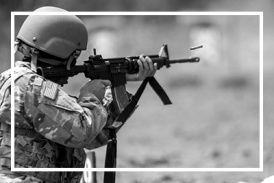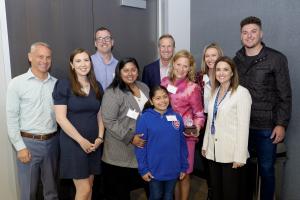CUBS CHARITIES CONTINUES TO STEP UP TO THE PLATE FOR CHICAGO'S NONPROFITS WITH NEARLY $2 MILLION IN GRANTS
Annual Gifts Benefit Organizations Facing Uncertain Funding Futures
“Cubs Charities selects organizations that are known in their communities for providing grass-roots programs and resources that help Chicago’s youth thrive,” says Cubs Charities Executive Director Lea Jesse. “In these uncertain economic times, Cubs Charities is honored to be a trusted resource for organizations across Chicago.”
This year’s grants and donations are projected to impact more than 322,000 youth and families in Chicago.
“Cubs Charities has invested in Chicago's youth for more than 30 years and will continue to do so through strategic grantmaking and community partnerships,” says Cubs Charities Board Chair Laura Ricketts. “Our initiatives help participants build skills on and off the baseball field, build futures through education, and help our partners build safe and accessible community spaces in neighborhoods across the city.”
Cubs Charities' annual grants are made through the Cubs Charities Community Fund, a fund of the Robert R. McCormick Foundation, the Cubs Charities Diamond Project, and All-Star School donations.
Cubs Charities Programs and Initiatives
Beyond grantmaking, Cubs Charities also creates safe spaces for Chicago’s youth through the Diamond Project, a community investment initiative that aims to respond to the immediate shortage of baseball and softball fields, reduce the equity gap of playing conditions and resources, and increase access for youth to play ball in their own communities.
Cubs Charities teaches youth the fundamentals of baseball and softball and how those skills can translate into everyday life through its Cubs Jr. All-Stars and Cubs Nike Reviving Baseball in Inner Cities (RBI) programs.
Cubs Jr. All-Stars unite fun diamond sport instruction with activities that help elementary-age children build social and emotional skills. Cubs RBI includes seasonal baseball and softball leagues, skills clinics and Cubs Nike RBI All-Stars, a nine-month player development program for select athletes.
The Careers As Sports Executives (CASE) study program engages high school students who are interested in sports—and perhaps careers in sports—who would otherwise not have the opportunity to get the training, experience, and tutelage to pursue entry-level jobs in sports.
The Cubs Scholars program provides high-potential Chicago students who have a demonstrated financial need with a team-sponsored mentorship program designed to promote academic achievement and post-secondary education. The program awards $20,000 scholarships to recipients enrolling in four-year colleges or universities and offers a mentoring program to help them transition from high school to college. Since 2013, 98 students have been awarded $1.96M in scholarships for college.
For more information about Cubs Charities, visit www.cubscharities.org.
About Cubs Charities
Cubs Charities is a nonprofit that mobilizes the power of sport to champion youth, families and communities. Cubs Charities’ work is focused on sports-based youth development and academic programming, investments in safe places to play and strategic grantmaking. Since 2009, Cubs Charities has invested more than $49 million in people, places and programs across Chicago. Cubs Charities is a leader among professional sports teams in its creation, execution and delivery of quality, sports-based youth development programming. Today, Cubs Charities’ portfolio includes programs that provide children and youth with skilled coaches, quality programming and safe and accessible places to play the game.
About The Robert R. McCormick Foundation
Robert R. McCormick Foundation envisions a Chicagoland with educated and informed individuals who are engaged in improving their communities. The Foundation invests in organizations working to build thriving communities where all individuals have the resources and opportunities to succeed without regard to income, race, ethnicity, gender, or ZIP code. Established in 1955 upon the death of Col. Robert R. McCormick, longtime editor and publisher of the Chicago Tribune, the McCormick Foundation has issued grants of approximately $2 billion. The Foundation’s board also oversees Cantigny, Col. McCormick’s 500-acre estate in Wheaton, Illinois, which encompasses a park, display gardens, a museum dedicated to the 1st Infantry Division of the U.S. Army, and a 27-hole public golf facility. Learn more at mccormickfoundation.org, cantigny.org, fdmuseum.org, and cantignygolf.com.
Cristina Vera Bridges
Vera Creative
+1 312-265-0326
cvera@veracreative.com
Visit us on social media:
LinkedIn
Instagram
Facebook
X
Legal Disclaimer:
EIN Presswire provides this news content "as is" without warranty of any kind. We do not accept any responsibility or liability for the accuracy, content, images, videos, licenses, completeness, legality, or reliability of the information contained in this article. If you have any complaints or copyright issues related to this article, kindly contact the author above.
Beacon Media + Marketing Releases Part 2 of Authentic Branding Series for Small Business Growth
Xtel Is a Winner in CRN’s 2025 Tech Innovators Awards
Inertia Resources, Inc, Grows Boston Footprint, Helping Local Businesses Cut Energy Costs
Więcej ważnych informacji
 Jedynka Newserii
Jedynka Newserii

 Jedynka Newserii
Jedynka Newserii

Polityka

D. Joński: Nie wiemy, co zrobi Rosja za dwa–trzy lata. Według duńskiego wywiadu może zaatakować kraje nadbałtyckie i musimy być na to gotowi
Zdecydowana większość krajów unijnych wskazuje na potrzebę wzmocnienia zdolności obronnych Europy w obliczu coraz bardziej złożonego geopolitycznego tła. Wywiady zachodnich państw wskazują, że Rosja może rozpocząć konfrontację z NATO jeszcze przed 2030 rokiem. Biała księga w sprawie obronności europejskiej „Gotowość 2030” zakłada m.in. ochronę granic lądowych, powietrznych i morskich UE, a sztandarowym projektem ma być Tarcza Wschód. – W budzeniu Europy duże zasługi ma polska prezydencja – ocenia europoseł Dariusz Joński.
Transport
Duże magazyny energii przyspieszą rozwój transportu niskoemisyjnego w Europie. Przyszłością może być wodór służący jako paliwo i nośnik energii

Zmiany w europejskim transporcie przyspieszają. Trendem jest elektromobilność, zwłaszcza w ramach logistyki „ostatniej mili”. Jednocześnie jednak udział samochodów w pełni elektrycznych w polskich firmach spadł z 18 do 12 proc., co wpisuje się w szerszy europejski trend spowolnienia elektromobilności. Główne bariery to ograniczona liczba publicznych stacji ładowania, wysoka cena pojazdów i brak dostępu do odpowiedniej infrastruktury. – Potrzebne są odpowiednio duże magazyny taniej energii. Przyszłością przede wszystkim jest wodór – ocenia Andrzej Gemra z Renault Group.
Infrastruktura
W Polsce w obiektach zabytkowych wciąż brakuje nowoczesnych rozwiązań przeciwpożarowych. Potrzebna jest większa elastyczność w stosowaniu przepisów

Pogodzenie interesów konserwatorów, projektantów, inwestorów, rzeczoznawców i służby ochrony pożarowej stanowi jedno z największych wyzwań w zakresie ochrony przeciwpożarowej obiektów konserwatorskich. Pożary zabytków takich jak m.in. katedra Notre-Dame w Paryżu przyczyniają się do wprowadzania nowatorskich rozwiązań technicznych w zakresie ochrony przeciwpożarowej. W Polsce obowiązuje już konieczność instalacji systemów detekcji. Inwestorzy często jednak rezygnują z realizacji projektów dotyczących obiektów zabytkowych z uwagi na zmieniające się i coraz bardziej restrykcyjne przepisy czy też względy ekonomiczne.
Partner serwisu
Szkolenia

Akademia Newserii
Akademia Newserii to projekt, w ramach którego najlepsi polscy dziennikarze biznesowi, giełdowi oraz lifestylowi, a także szkoleniowcy z wieloletnim doświadczeniem dzielą się swoją wiedzą nt. pracy z mediami.




![Nestlé w Polsce podsumowuje wpływ na krajową gospodarkę. Firma wygenerowała 0,6 proc. polskiego PKB [DEPESZA]](https://www.newseria.pl/files/1097841585/fabryka-nesquik_1,w_85,r_png,_small.png)




.gif)

 |
| |
| |
|